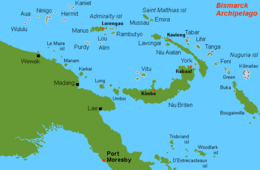TheBismarck Archipelago(German:Bismarck-Archipel,pronounced[ˈbɪsmaʁkˌaʁçiˈpeːl]) is a group of islands off the northeastern coast ofNew Guineain the western Pacific Ocean and is part of theIslands RegionofPapua New Guinea.Its area is about 50,000 square kilometres (19,000 sq mi).
 Satellite view of the islands of New Britain and New Ireland, the two largest in the Bismarck Archipelago | |
 | |
| Geography | |
|---|---|
| Location | Papua New Guinea |
| Coordinates | 5°00′S150°06′E/ 5.000°S 150.100°E |
| Major islands | New Britain,New Ireland |
| Area | 49,700 km2(19,200 sq mi) |
| Highest elevation | 2,340 m (7680 ft) |
| Highest point | Mount Taron |
| Administration | |
Papua New Guinea | |
| Region | Islands Region |
History
editThe first inhabitants of thearchipelagoarrived around 30,000–40,000 years ago.[1]They may have traveled from New Guinea, by boat across theBismarck Seaor via a temporaryland bridge,created by an uplift in the Earth'scrust.[citation needed]Later arrivals included theLapitapeople, the direct ancestors of theAustronesian peoplesofPolynesia,easternMicronesia,and IslandMelanesia.
The first European to visit these islands was Dutch explorerWillem Schoutenin 1616.[2][3]The islands remained unsettled by western Europeans until they were annexed as part of the GermanprotectorateofGerman New Guineain 1884. The area was named in honour of theChancellorOtto von Bismarck.
On13 March 1888,avolcanoerupted onRitter Islandcausing amegatsunami.Almost the entire volcano fell into the ocean, leaving a smallcrater lake.[4]
Following the outbreak ofWorld War I,theAustralian Naval and Military Expeditionary Forceseized the islands in 1914 and Australia later received aLeague of Nations mandatefor the islands. They remained under Australian administration—interrupted only byJapaneseoccupation duringWorld War II—until Papua New Guinea became independent in September 1975.
Geography
editThe Bismarck Archipelago includes mostlyvolcanic islandswith a total land area of 49,700 km2(19,189 sq mi). The archipelago surrounds theBismarck Seaand sits upon theNorth Bismarck Plate,theManus Plateand theSouth Bismarck Plate.
Islands are grouped here according to administrative province:
- Manus Province(see 9 on the map)
- Admiralty Islands,group of 18 islands including:
- Western Islands,with:
- New Ireland Province(12)
- New Irelandor also Niu Ailan, main island
- New Hanoveror Lavongai
- St Matthias Islands
- Tabar Group
- Lihir Group
- Tanga Group
- Feni Islands
- Dyaul Island
Rabaul caldera,New Britain
- East New BritainProvince (4)
- New Britainor also Niu Briten, main island
- Duke of York Islands
- West New BritainProvince (18)
- New Britainor also Niu Briten, main island
- Vitu Islands
- Morobe Province(11)
- Madang Province(8)
- East SepikProvince (5)
The passage of water between the islands of New Britain and New Ireland is calledSt. George's ChannelafterSt. George's Channelin the British Isles between Wales and Ireland.
See also
editNotes
edit- ^Leavesley, Matthew G. and Chappell, John."Buang Merabak: additional early radiocarbon evidence of the colonisation of the Bismarck Archipelago, Papua New Guinea".Antiquity.Durham University.Archivedfrom the original on 4 March 2018.Retrieved4 March2018.
{{cite web}}:CS1 maint: multiple names: authors list (link) - ^Sigmond, J. P. and Zuiderbann, L. H. (1976)Dutch Discoveries of Australia,Rigby, Australia.ISBN0-7270-0800-5
- ^Spate, O. H. K. (1979)The Spanish Lake,Australian National University, Second Edition, 2004.ISBN1-920942-17-3
- ^Ward, Steven N.; Day, Simon (September 2003)."Ritter Island Volcano —Lateral Collapse and the Tsunami of 1888".Geophysical Journal International.154(3). Blackwell Publishing: 891.Bibcode:2003GeoJI.154..891W.doi:10.1046/j.1365-246X.2003.02016.x.
In the early morning of 1888 March 13, roughly 5 km3[1.2 cu mi] of Ritter Island Volcano fell violently into the sea northeast of New Guinea. This event, the largest lateral collapse of an island volcano to be recorded in historical time, flung devastating tsunami tens of metres high on to adjacent shores. Several hundred kilometres away, observers on New Guinea chronicled 3-min period waves up to 8 m [26 ft] high, that lasted for as long as 3 h. These accounts represent the best available first-hand information on tsunami generated by a major volcano lateral collapse. In this article, we simulate the Ritter Island landslide as constrained by a 1985 sonar survey of its debris field and compare predicted tsunami with historical observations. The best agreement occurs for landslides travelling at 40 m/s [130 ft/s], but velocities up to 80 m/s [260 ft/s] cannot be excluded. The Ritter Island debris dropped little more than 800 m [2,600 ft] vertically and moved slowly compared with landslides that descend into deeper water. Basal friction block models predict that slides with shorter falls should attain lower peak velocities and that 40+ m/s [130 ft/s] is perfectly compatible with the geometry and runout extent of the Ritter Island landslide. The consensus between theory and observation for the Ritter Island waves increases our confidence in the existence of mega-tsunami produced by oceanic volcano collapses two to three orders of magnitude larger in scale.
Bibliography
edit- Firth, Stewart (1983).New Guinea Under the Germans.Carlton, Australia: Melbourne University Press.ISBN0-522-84220-8.
- Howe, K. R., Robert C. Kiste, Brij V. Lal, eds. (1994).Tides of History: The Pacific Islands in the Twentieth Century.Honolulu: University of Hawaii Press.ISBN0-8248-1597-1.
- King, Davidet al.(1982).Papua New Guinea Atlas: A Nation in Transition.Bathurst, Australia: R. Brown and the University of Papua New Guinea.ISBN0-909197-14-8.
- Moore, Clive (2003).New Guinea: Crossing Boundaries and History.Honolulu: University of Hawaii Press.ISBN0-8248-2485-7.
- Ryan, Peter, ed. (1972).Encyclopedia of Papua New Guinea.3 volumes; Vol I: A – K, maps, black and white illustrations, xv + 588pp. Vol II: l – Z, maps, black and white illustrations, 589–1231pp. Vol III: Index, folding colour map in rear pocket, map, colour illustration, v + 83pp. Carlton, Australia: Melbourne University Press.ISBN978-0-522-84025-4.
External links
edit- .Encyclopædia Britannica(11th ed.). 1911.
- ..1914.